Digital Poster
Preclinical in Brain Imaging
ISMRM & ISMRT Annual Meeting & Exhibition • 10-15 May 2025 • Honolulu, Hawai'i

 |
Computer Number: 129
3939. Longitudinal
In Vivo Mapping of Alpha-Synuclein Aggregation in Parkinson’s
Disease Using rNOE Imaging
J. Prasuhn, J-J Song, F. Akkentli, T-I Kam, Y. Li, Q. Zeng,
Z. Yang, S. Ali, L. Knutsson, V. Dawson, T. Dawson, P. van
Zijl, N. Yadav
Johns Hopkins University School of Medicine, Baltimore, United States
Impact: rNOE imaging has potential as a surrogate
biomarker for protein aggregation changes associated with
Parkinson’s disease (PD) progression. This methodology has
the potential to guide the development of therapies
targeting protein aggregation, advancing neuroprotective
strategies and disease management in PD.
|
|
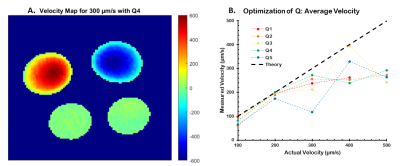 |
Computer Number: 130
3940. Measuring
Slow Cerebrospinal Fluid Velocities in Preclinical Models Using
Optimized Phase Contrast MRI at 21.1 T
D. Richter, C. Blan, M. Elumalai, S. Grant
National High Magnetic Field Laboratory, Tallahasseee, United States
Impact: A successful and non-invasive MR method would
allow for longitudinal assessment of CSF dynamics in
neurological disorders, such as Alzheimer's disease or
migraine, impacting both preclinical models and clinical
monitoring of potential brain waste clearance mechanisms.
|
|
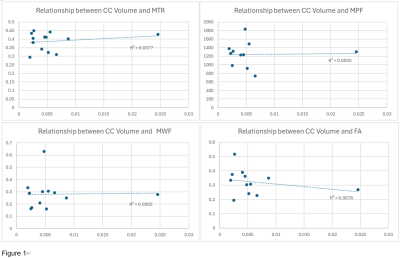 |
Computer Number: 131
3941. Comparative
Study of Corpus Callosum Volume and Myelin Indices (MPF, MWF,
MTR, FA) across Mammals: Independent Variability and Evolution
K. Nishigami, H. Hamaguchi, N. Patzke, M. Kitagawa, T. Khin
Laboratory for Biomarker Imaging Science, Hokkaido University Graduate School of Biomedical Science and Engineering, Sapporo, Japan, sapporo, Japan
Impact: These findings highlight that corpus callosum
volume and myelin metrics can serve as independent markers
in neuroimaging studies. This independence suggests distinct
evolutionary paths for brain connectivity in different
species,with implications for understanding neurological
health and developing myelin-related diagnostic tools
|
|
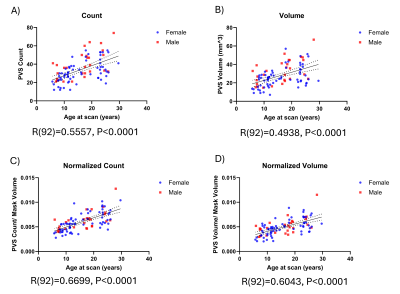 |
Computer Number: 132
3942. Prevalence
of MR-visible perivascular spaces increases with age in rhesus
macaques.
W. Liguore, D. Schwartz, J. Karpf, S. Kohama, L. Silbert, A.
Weiss
Oregon National Primate Research Center, Beaverton, United States
Impact: This is the first study to report MR-visible PVS
in rhesus macaques, providing a model for investigating
underlying mechanisms and potential therapeutic strategies.
|
|
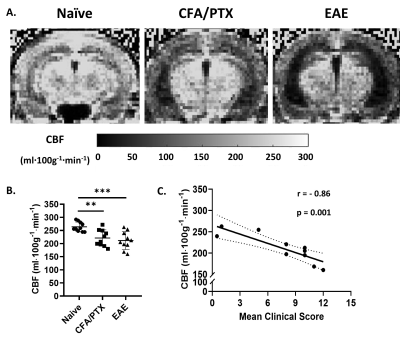 |
Computer Number: 133
3943. MRI
shows reduction of CBF and increased hypoxia relate to disease
severity in the EAE mouse model of Multiple Sclerosis
M. Hashem, R. Tariq, A. Palset, Y. Wu, E. Wuerch, V. Yong,
J. Dunn
University of Calgary, Calgary, Canada
Impact: Developing non-invasive MRI metrics as
biomarkers of hypoxia, hypoperfusion and disease severity in
the EAE NAGM is critical to enhance our understanding of the
mechanisms driving MS progression and potentially improve
treatment strategies.
|
|
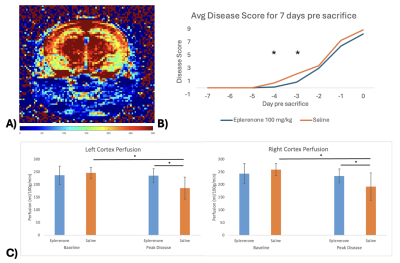 |
Computer Number: 134
3944. Arterial
Spin Labeling MRI to Investigate Mineralocorticoid
ReceptorAntagonism Effect on Brain Perfusion in the EAE Model
M. Rahman, M. Hashem, D. Selimos, E. Wuerch, Y. Wu, W. Yong,
J. Dunn
University of Calgary, Calgary, Canada
Impact: These findings suggest early treatment with
mineralocorticoid receptor antagonists could prevent
vascular dysfunction in MS patients, potentially avoiding
cortical hypoxia. This introduces a new therapeutic approach
targeting blood flow regulation rather than traditional
immunomodulation strategies.
|
|
 |
Computer Number: 135
3945. Brain
volumetric analysis across the lifespan of the squirrel monkey
model of Alzheimer’s disease pathology
M. Soliman, S. Khan, C. Kingsley, J. Swain, M. Mulholland,
W. Hopkins, T. Wisniewski, Y. Wadghiri, J. Veraart, H.
Scholtzova
NYU Grossman School of Medicine, New York, United States
Impact: These results highlight the potential
contributions of CAA and vascular dysfunction to brain
volumetric changes in the SQM model. Our preliminary
findings underline the utility of this unique species for
future translational research on CAA/AD and advancing MRI
biomarkers.
|
|
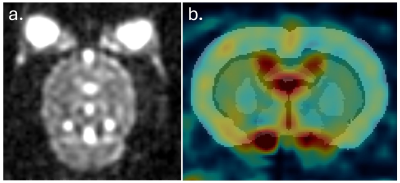 |
Computer Number: 136
3946. Ultra-High
Field Sodium MRI to Assess Longitudinal Sodium Dysfunction in a
Preclinical Transgenic Alzheimer's Disease Model
J. Radovich, M. Elumalai, S. Grant
National High Magnetic Field Laboratory, Tallahasseee, United States
Impact: Sodium concentrations fluctuate with age and
region within the brain. The AD model appears to follow
similar trends to the WT overall but are muted, with greater
variance and generally higher early signals, underscoring
the diagnostic potential of sodium MRI.
|
|
 |
Computer Number: 137
3947. Assessing
the protective roles of taurine in Alzheimer's disease mouse
models
Z. M. Suar, R. Ghosh Biswas, C. Tognoni, I. Carreras, A.
Dedeoglu, B. Jenkins
Massachusetts General Hospital, Boston, United States
Impact: Taurine supplementation led to an increase in
brain taurine levels. It protected decreased CBF and
increased iron deposition as well as preventing decreases
in NAA and other metabolites associated with progression
of AD pathology - further study is warranted.
|
|
 |
Computer Number: 138
3948. Oligomeric
amyloid-β targeted contrast agent for MRI in Mouse Models of
Alzheimer's disease
G-H Jahng, J. W. Park, Y. Tian, C. Park, H. K. Chung, K. M.
Kim
Kyung Hee University Hospital at Gangdong, Seoul, Korea, Republic of
Impact: Our novel contrast agent targeting oAβ has the
potential ability to diagnose early AD and monitor the
progression of AD.
|
|
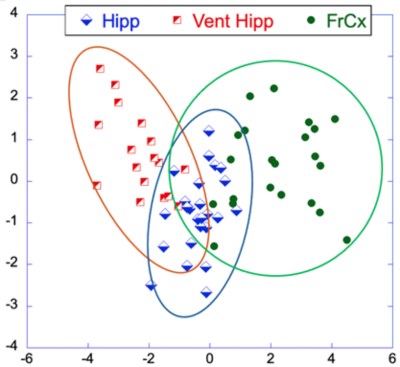 |
Computer Number: 139
3949. MRS
Metabolic Differentiation of Alzheimer’s Disease in Mice Across
Three Brain Regions to Explore Changes in Response to Anesthesia
in Surgery
R. Ghosh Biswas, Z. Suar, C. Tognoni, I. Carreras, A.
Dedeoglu, Y. Zhang, Z. Xie, L. Cheng, B. Jenkins
Massachusetts General Hospital, Charlestown, United States
Impact: HRMAS-MRS, machine learning and 5 neurochemical
metabolites differentiated the dorsal hippocampus, ventral
hippocampus and frontal cortex, with the largest separation
between the latter two. This created a baseline metabolomic
profile to probe the impact of anesthesia as an AD-promoting
stimulus.
|
|
 |
Computer Number: 140
3950. R2*
Mapping in a Primate Model of CAA Shows Aging-Related Increases
in GM and Reversal in WM with Transient Edema
Y. Wadghiri, J. Szabo, S. Khan, M. Soliman, S. Murray, C.
Kingsley, S. Gray, J. Swain, W. Hopkins, J. Veerart, T.
Wisniewski, H. Scholtzova
NYU Grossman School of Medicine, NEW YORK, United States
Impact: ARIA is a condition seen during the
pharmaceutical treatment of AD. Studying SQM can offer
valuable insights into the disease mechanisms.
|
|
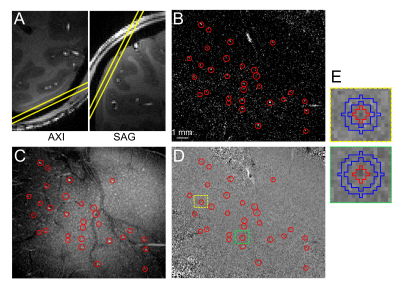 |
Computer Number: 141
3951. Cerebral
blood velocity of small intracortical blood vessels in macaque
monkey measured by quantitative phase-contrast MRI at 7T
J. Wang, Y. Feng, A. Ping, F. Tian, M. Chen, Y. Liu, L. Lin,
Y-C Hsu, A. Roe, J. Polimeni
Affiliated Mental Health Center & Hangzhou Seventh People's Hospital, Zhejiang University School of Medicine, Hangzhou, China
Impact: Using a standard human 7T MRI scanner, we
measured the velocity of micron-scale intracortical vessels
non-invasively in primates. This study paves the way to
understand intracortical vessel function in relation to
functional organization and clinical application using
non-human primate model.
|
|
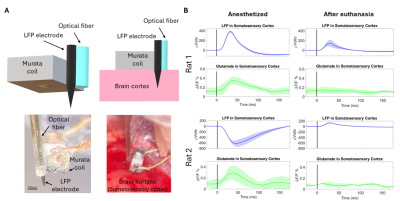 |
Computer Number: 142
3952. Feasibility
of MRI-Guided Micro-Coil Positioning to Enhance Precision in
Micro-Magnetic Stimulation (μMS) and Preliminary Application in
Rats
F. Marturano, L. Gomez-Cid, A. Mareyam, J. Stockmann, E.
Kazemivalipour, X. Yu, I. Ay, G. Bonmassar
Massachusetts General Hospital, Harvard Medical School, Charlestown, United States
Impact: We have preliminarily demonstrated the
feasibility of using MRI to overcome the challenges of
precise micro-coil placement in μMS applications, which
could enhance stimulation accuracy and selectivity, thereby
inducing spatially confined activation and minimizing the
risks of unintended stimulation.
|
|
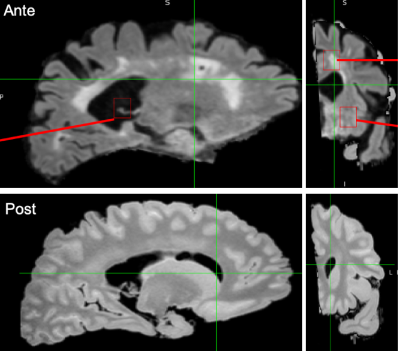 |
Computer Number: 143
3953. White
mater hyperintensities and microplastics
E. Bearer, N. Adolphi, M. Garcia, M. Campen
University of New Mexico Health Sciences Center, Albuquerque, United States
Impact: Microplastics in the brain of people with
cognitive impairment may be due to pre-existing vascular
injury or contribute to it. Many questions remain: Where do
they come from, does they impair functional? Can they be
diagnosed by MRI ante-mortem?
|
|
 |
Computer Number: 144
3954. DTI-based
assessment of disease progression in a mouse model of white
matter stroke
F. Schmid, N. Tirukoti, G. Duenas, W. Kong, E. Malahias, P-H
(. Tai, I. Llorente, J. Riegler
Calico Life Sciences, South San Francisco, United States
Impact: Characterization of MRI biomarkers of
progression of white matter lesions combined with insight
into cellular processes by spatial transcriptomics in this
mouse model will allow for better evaluation of treatment
candidates for white matter stroke and vascular dementia.
|
The International Society for Magnetic Resonance in Medicine is accredited by the Accreditation Council for Continuing Medical Education to provide continuing medical education for physicians.